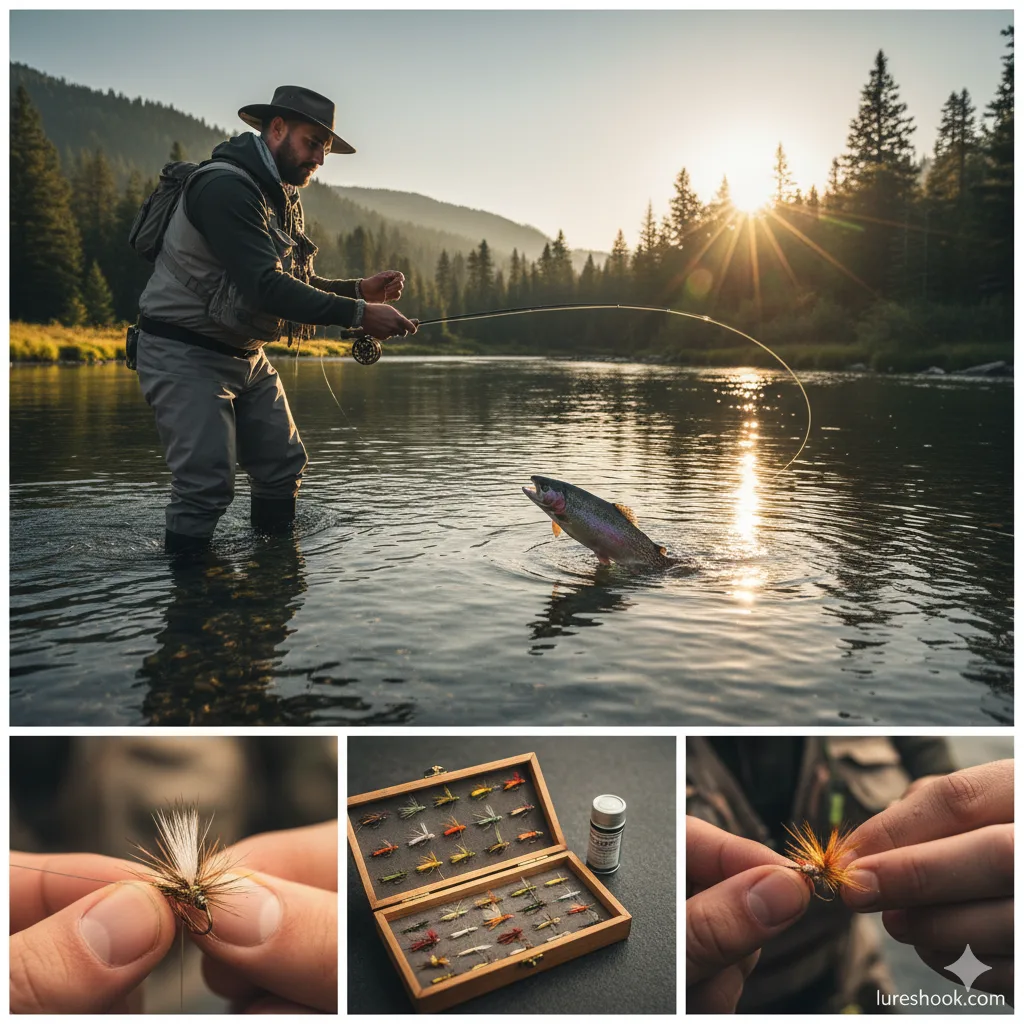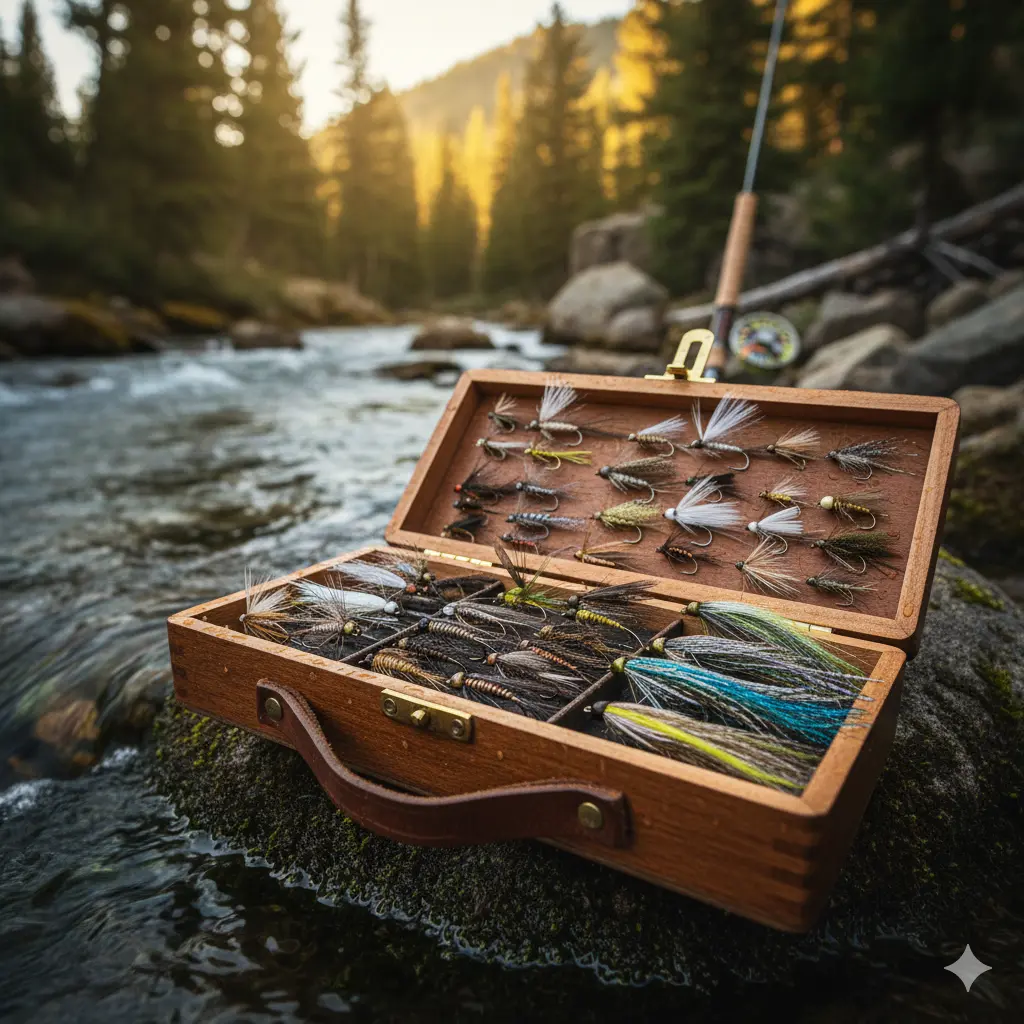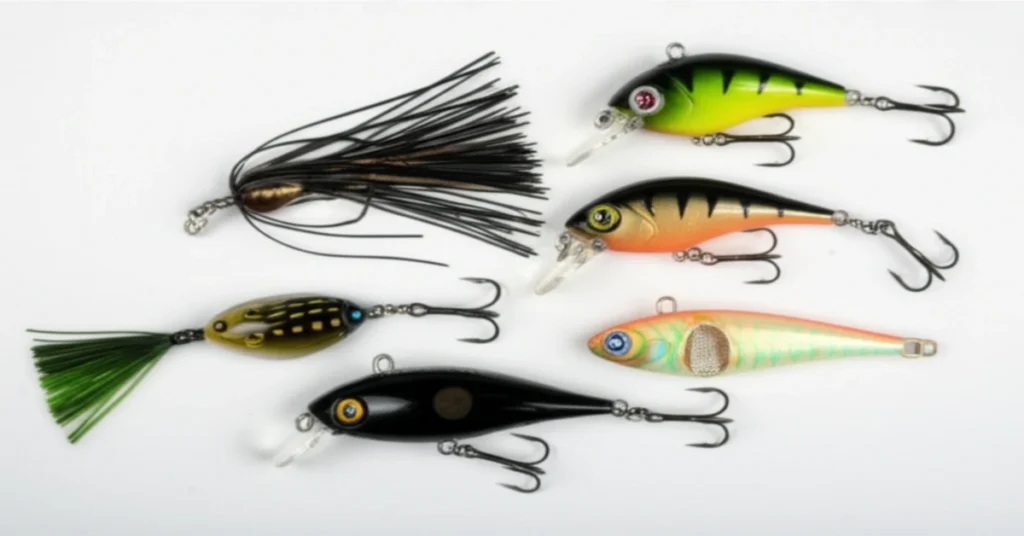Dry Fly Fishing: The Ultimate Guide to Surface Strikes & Trout On the Rise in 2025
Experience the magic of dry fly fishing. Our ultimate guide covers essential gear, classic dry fly patterns, and advanced techniques to help you master the art of catching fish on the surface and trigger more explosive strikes.
Table of Contents
- What Are Dry Flies?
- Why Dry Flies Are So Effective
- Types of Dry Flies & Classic Patterns
- Rigging & Presenting a Dry Fly
- Essential Dry Fly Fishing Techniques
- Species-Specific Dry Fly Strategies
- Essential Gear for Dry Fly Fishing
- Pro Tips & Advanced Dry Fly Strategies
- Frequently Asked Questions About Dry Flies
What Are Dry Flies?
Dry flies are a type of artificial fishing lure designed to imitate an adult insect that has landed or fallen onto the surface of the water. Unlike nymphs that sink or streamers that imitate baitfish, a true dry fly is tied with buoyant materials—like deer hair, elk hair, or hackle feathers—that allow it to float. The goal is to perfectly mimic a living insect, presenting it as a natural, defenseless meal for fish feeding on the surface.
Why Dry Flies Work So Well
Fishing with dry flies is widely considered one of the most exciting and rewarding forms of angling because:
- Visual Excitement: The most thrilling part of dry fly fishing is watching a fish rise to the surface to take your fly. The visual strike is an unforgettable experience.
- Mimics Natural Food: During an insect hatch, fish often key in on the abundance of food on the surface. A well-presented dry fly is a perfect imitation of this natural forage.
- Subtle Presentation: A delicate dry fly landing softly on the water causes minimal disturbance, which is crucial for not spooking wary trout in clear, calm water.
- Targeting Feeding Fish: A dry fly is the best tool for targeting fish that you can visibly see “rising” to the surface to feed.
When to Use Dry Flies
Dry fly fishing excels in these situations:
- During a Hatch: When you see insects flying around and fish are actively rising, a dry fly is the ideal choice.
- Calm & Clear Water: When the water is smooth, a flawless presentation is possible, and fish can easily spot your fly.
- Specific Seasons: Dry fly fishing is most productive in late spring, summer, and early fall when insect activity is at its peak.
Skill Level: Intermediate to Advanced
While the concept is simple, achieving a “drag-free drift” and making a delicate presentation requires practice and understanding of casting mechanics, making it more challenging than some other methods.
Beginner Rating: 5/10 – Requires practice but offers a lifetime of rewarding challenge.
Types of Dry Flies & Classic Patterns
The vast world of dry flies is categorized by the type of insect they imitate. Having a variety of these patterns is key to matching the “hatch” on any given day.
1. Mayfly Imitations
The most common type of aquatic insect that trout feed on.
- Parachute Adams: A universal “attractor” pattern that can imitate many different mayfly species. Its parachute design makes it highly visible and buoyant.
- Elk Hair Caddis: While technically a caddisfly imitation, this is a must-have due to its buoyancy and ability to imitate many common flying insects.
- Blue Winged Olive (BWO): A key pattern for spring and fall hatches on overcast days.
2. Caddisfly Imitations
Known for their fast, erratic flight patterns, often causing splashy strikes.
- Elk Hair Caddis: The most famous caddis imitation, its buoyant elk hair wing is perfect for riding high in fast-moving water.
- Stimulator: A large, bushy fly that imitates caddisflies, stoneflies, and even grasshoppers. It’s a great “search” pattern.
3. Terrestrials (Land-based insects)
Insects that fall into the water from streamside vegetation.
- Chubby Chernobyl: A large, foam-bodied fly that imitates grasshoppers, crickets, and cicadas. Excellent as a “dry-dropper” indicator.
- Ant & Beetle Patterns: Tiny, simple flies that imitate ants or beetles. Crucial in late summer and early fall when these insects are prevalent.
4. Attractor Patterns
These flies don’t imitate a specific insect but are designed to attract fish’s attention with their unique color or profile.
- Royal Wulff: A highly visible and classic pattern with white calf tail wings and a striking red body. A confidence booster for any angler.
Rigging & Presenting a Dry Fly
A successful dry fly presentation is all about stealth and a “drag-free drift.” Here’s how to set up and prepare your rig.
1. The Leader & Tippet
- Tapered Leader: A tapered leader is essential. It’s a single strand of monofilament that gradually reduces in diameter from the thick butt section (connected to the fly line) to a fine point. This taper helps transfer casting energy, allowing the fly to turn over correctly.
- Tippet: A separate, fine piece of monofilament or fluorocarbon tied to the end of the leader. It’s where you’ll tie your fly. This saves your expensive tapered leader from getting shorter with every fly change.
- The “X” System: Tippet and leaders are measured in an “X” system. The higher the number, the thinner the material (e.g., 5X is thinner than 3X). A good rule of thumb is to divide your fly size by three to get a good starting tippet size (e.g., a size #12 fly works well with 4X tippet).
2. Adding Floatant
Floatant is a crucial accessory for dry fly fishing. It’s a paste, gel, or powder that you apply to your fly to waterproof it and help it float. Apply it generously to the hackle and body of the fly, but avoid the “wing” to maintain its delicate profile.
3. Knots
- Improved Clinch Knot: A reliable knot for connecting the tippet to the fly.
- Surgeon’s Knot: An easy and strong knot for connecting a new piece of tippet to the end of your leader.
Essential Dry Fly Fishing Techniques
The goal is a “drag-free drift,” where your fly floats at the same speed as the current, just like a natural insect.
1. The Drag-Free Drift
- Technique: Cast your fly a few feet upstream of a rising fish. The key is to manage your line as it drifts downstream to prevent it from pulling the fly. Any unnatural movement from the line will cause “drag” and spook the fish.
- Line Management (Mending): As your fly drifts, use the tip of your rod to “mend” the line—a subtle lift and repositioning of the line to take out any curves that might cause drag.
2. The “Rise” Cast
- Technique: Instead of casting directly at the fish, cast a few feet upstream of its rise. This gives the fly time to settle on the water and drift naturally into the fish’s feeding lane.
- Key Insight: Watch the fish’s rise form. If a trout is rising consistently in one spot, it’s likely holding and feeding in a predictable location.
3. The “Twitch” or “Skate”
- Technique: While a drag-free drift is usually best, sometimes a subtle twitch of the fly can trigger a strike, especially when imitating a caddisfly or a struggling insect. Gently wiggle the tip of your rod to make the fly “dance.”
- When to Use: When fish seem to be ignoring a perfect dead drift or when a caddis hatch is in full swing.
Species-Specific Dry Fly Strategies
While most associated with trout, dry flies can be deadly for other species.
1. Trout Fishing with Dry Flies ⭐⭐⭐
- Target Species: Rainbow Trout, Brown Trout, Brook Trout.
- Technique: Focus on a flawless, drag-free drift. Pay attention to the “hatch” and choose a fly that matches the size and color of the insects on the water. Fish in seams, eddies, and tailouts.
- Top Patterns: Parachute Adams, Elk Hair Caddis, Royal Wulff, Blue Winged Olive.
2. Bass & Panfish with Dry Flies ⭐⭐
- Target Species: Largemouth & Smallmouth Bass, Bluegill, Sunfish.
- Technique: Unlike trout, these fish are often less spooky. Use larger, more aggressive patterns. “Poppers” are a classic dry fly for bass, designed to create a disturbance on the surface.
- Top Patterns: Foam Poppers, Terrestrials (like grasshoppers), and large Stimulators.
Essential Gear for Dry Fly Fishing
Having the right gear is crucial for making the delicate casts and presentations that dry fly fishing requires.
1. Rod & Reel
- Rod: A 9-foot, 4-weight or 5-weight rod is the ideal “all-around” choice. A 4-weight offers delicate presentation for smaller flies, while a 5-weight handles larger flies and wind better.
- Reel: A simple, single-action reel with a smooth, reliable drag system is all you need. Its primary function is to hold the line.
2. Fly Line
- Floating Fly Line: This is non-negotiable. You must use a floating line for dry fly fishing. The line’s buoyancy helps it stay on the surface, supporting the fly and preventing it from sinking.
3. Accessories
- Fly Box: A fly box with foam inserts to hold your dry flies securely without crushing their delicate hackle and wings.
- Floatant: A paste or gel to keep your flies buoyant.
- Nippers & Hemostats: Small clippers for cutting line and hemostats for removing hooks from fish.
- Landing Net: Essential for safely landing and releasing fish.
Pro Tips & Advanced Dry Fly Strategies
Refine your skills with these expert tips to make your dry fly game more effective.
1. Stay Low & Stealthy
- Why: Fish can see you! Especially in clear water, your shadow or a sudden movement can spook them. Crouch low, move slowly, and stay out of their direct line of sight.
2. Don’t Cast at the Fish
- Cast Ahead: Instead of casting directly to a fish, cast a few feet upstream of it. This gives the fly a chance to settle and drift naturally into the fish’s feeding zone.
3. Keep Your Fly Clean
- After a Catch: After catching a fish, your dry fly will be waterlogged and full of slime. Use a small cloth or amadou patch to blot the fly dry and reapply floatant.
4. Learn to “Match the Hatch”
- Observe the Water: Take time to observe what’s on the water. Look for the size, color, and profile of the natural insects. Your fly box should have patterns that mimic these bugs.
5. Fish “Pocket Water”
- What it is: Pocket water is the choppy, turbulent water found in fast-moving streams. While a drag-free drift is harder, the broken surface hides your line and mistakes, making it a great place to fish.
Frequently Asked Questions About Dry Flies
Q: What is the difference between a dry fly and a nymph? A: A dry fly floats on the surface and imitates an adult insect. A nymph is a weighted fly that sinks and imitates the larval stage of an insect, which is what fish feed on below the surface most of the time. Q: When is the best time to fish with dry flies? A: The best time is during an insect hatch, when you can see fish actively rising to the surface to feed. This typically occurs in the afternoon or evening on mild, overcast days from spring through fall. Q: Can I use both a dry fly and a nymph at the same time? A: Yes! This is a popular and highly effective technique called a “dry-dropper” rig. You use a large, buoyant dry fly as an indicator and a lighter nymph tied a few feet below it. The dry fly holds the nymph up and helps you see a strike. Q: Is dry fly fishing only for trout? A: While most associated with trout, dry flies are also very effective for catching species like bass, bluegill, sunfish, and even panfish. Using larger foam-bodied patterns like poppers or terrestrials is a great way to target them.
Conclusion: The Timeless Art of Dry Fly Fishing
Dry fly fishing is a pure and engaging form of angling that connects you directly to the natural rhythms of the water. While it may require patience and a refined technique, the reward of seeing a fish break the surface to take your carefully presented fly is a feeling that no other fishing method can match. It’s an art form that transforms fishing from a simple pursuit into a captivating dance between angler and fish.
Key takeaways for dry fly fishing success:
- ✅ Master the Drift: A drag-free drift is the most crucial skill.
- ✅ Match the Hatch: Pay attention to the insects on the water and choose a fly that matches their size and profile.
- ✅ Be Stealthy: Move slowly, stay low, and cast with a delicate touch.
- ✅ Use the Right Gear: A floating line and a properly tapered leader are non-negotiable.
Whether you’re a seasoned angler looking for a new challenge or a fly fishing enthusiast seeking the pinnacle of the sport, dry fly fishing will undoubtedly provide a lifetime of thrilling moments and unforgettable memories on the water.
Related Guides:
- Nymph Fishing 101: Understanding the Subsurface Game
- Fly Casting Basics: Your First Steps to Becoming an Angler
- Seasonal Strategies for Trout Fishing
- Essential Fly Fishing Knots for Every Angler
Share your favorite dry fly patterns or most memorable surface strikes in the comments below!



